[UPDATE 7/26/2017: This article was amended to include a statement that MTA Chairman Joseph Lhota made at the press conference on 7/25/2017 regarding his and the MTA’s accountability for the plan outlined here.]
This afternoon MTA Chairman Joseph Lhota laid out a short-term plan to improve declining service across the New York City subway system.
Lhota began by outlining some of the causes of the current deterioration of service, including a record volume of customers (6 million riders a day, due in no small part to increased number of tourists), lack of capital investment, and aging infrastructure.
The first phase of the MTA’s efforts will tackle the causes behind 79 percent of major delays. While medical incidents, track fires, car malfunctions, water damage, and station malfunctions were each the blame, more than half of the major delays were due to signal, track, and power problems. Lhota’s list of countermeasures was extensive, but included:
- Speeding up the replacement of the 1,300 most troublesome signals (40 percent of signal mechanisms are more than 50 years old)
- Starting a Emergency Water Management initiative to seal leaks and clean grates
- Increasing the number of train car overhauls from 950 to 1,100 per year
- Creating a new MTA app and a separate online dashboard to keep riders informed on MTA activities and improvements (the dashboard will be available in the next month to six weeks)
- Initiating a pilot program to remove some seats from select cars on the Shuttle (S) train between Grand Central/42nd and the L train
- Adding seven more EMT teams at various stations to handle sick customers
- Initiating a public awareness campaign to stop littering on the tracks, which can lead to track fires
- Increasing the rate of station cleaning from every six weeks to four weeks
- Adding 12 emergency teams to 12 locations to speed up incident response times
- Eliminating recorded announcements on subway cars
The cost will be a challenge—this yearlong “stabilization” phase will cost $456 million in operating costs, plus $380 million in a one-time capital. Without access to funds from the Triborough Bridge and Tunnel Authority, the federal government, or increased fares, the city and the state will have to food the bill. Lhota said that he and Governor Andrew Cuomo are proposing the two entities split the cost evenly.
In discussing the ever-prickly funding issue, Lhota, echoing Cuomo, made sure to note that the MTA runs the subway, while the city owns it (the mayor’s office disputes this interpretation of the subway’s rules).
Phase Two will include implementing the designs of the MTA Genius Transit Challenge, new subway cars, and an entirely new signal system. Lhota stated this second phase may cost $8 billion. During the conference, Lhota said the MTA would take responsibility for executing this plan. “Hold me accountable for everything that I’ve talked about today,” he stated in response to a reporter’s question, “because I do believe the responsibility begins here and ends here with everyone at the MTA and everyone at the transit authority.”
Hours after the press conference, Mayor Bill de Blasio held his own presser inside the City Hall R/W station to address Lhota’s remarks.
He called the agency’s plan a “positive” and “important” first step to getting subway service back up to par, noting that the state needs to apply the resources it already has at its disposal.
“The MTA is finally beginning to own up to its responsibility,” he said.
All good, right?
Less than two hours later, Lhota issued a salty response to de Blasio’s comments, fanning the flames of a city-state saga that’s already sardine-packed with petty jabs, light shows, messy snacking, and a whole heap of grandstanding:










